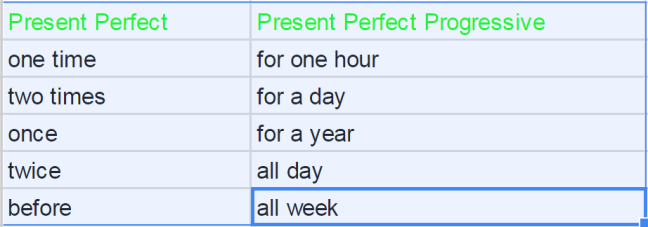In English, we have 12 verb tenses.
Present Tense:
This tense is used for regularly repeated actions or regularly not happening actions. E : My mom watches TV every night.
Past Tense:
Something that happened in the past. E: I broke my leg last weekend.
Future Tense:
An action that didn’t happen yet, but will happen in the future. E: I will enter MIT.
Present Progressive:
An action that is happening right now, but didn’t end yet. E: Mom is watching TV.
Past Progressive:
An action that was happening in the past when other action in the past happened. E:
I was waiting for her when she arrived her room. In this sentence, the first part is Past Progressive. Simple Progressive tenses have the form S + to be + V + ing .
Future Progressive:
Something that will be happening in future when some other action in future happens. E:
I will be doing homework when you arrive home
.
Present Perfect:
Is used to describe something that happened in the past before now. E: John has eaten Kabab before. In present perfect ‘now’ is important, in other words, an action happened before now. Something already finished until now.
Past Perfect:
Describes an action that already happened before another action in the past happened. In other words, first action happened before the second action. It is important to note that both of actions happened in the past. They have nothing to do with the present. E:
Jumabek had not studied seriously until he failed miserably in the exam.
This sentence is trying to say that in the past Jumabek did not study hard, but after he failed from his exam he started to take the exams seriously. Notice the usage of
‘had’ instead of ‘did’ in the example. One happened before the other is going to be past perfect.
Future Perfect:
Used to show that something in future will happen before the other. whatever happens first is future perfect. E:
By next year, I will have published two articles.
Present Perfect Progressive:
Indicates a continuous action that is happening right now in the present. Something is happening in Present Perfect but continuously (progressively). It consist of a form S + have + been + verb + ing. E: He has been waiting for her for a long time. It means an act of waiting may or may not be completed, in other words, it is continuous in the present. The difference between Present Perfect and Present Perfect Progressive is the time that action goes on.
Past Perfect Progressive:
Indicates a continuous action that was completed at some point in the past.
Future Perfect Progressive:
The future perfect progressive tense is used to talk about an action that will already have started and will still be happening by a certain time in the future.
